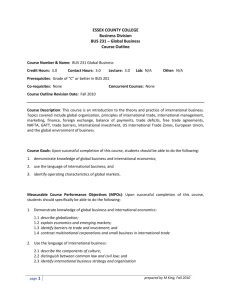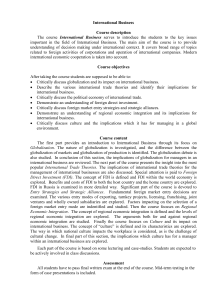International Management
advertisement
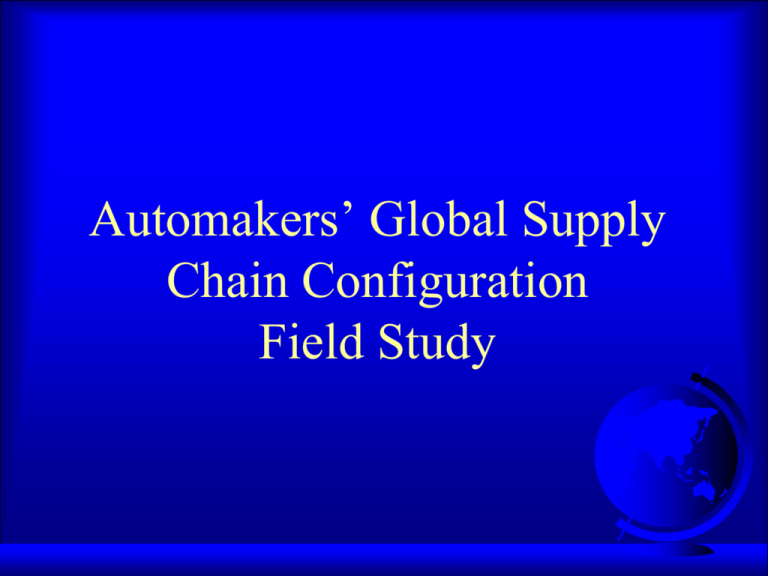
Automakers’ Global Supply Chain Configuration Field Study Country of Origin for VW Models Sold in U.S.: Major Components and Final Assembly Touareg Passat Jetta Beetle Golf Engine Germany Hungary Germany Poland Mexico Mexico Hungary Transmission Japan Japan Argentina Japan Argentina Japan Argentina Final Assembly Slovakia Germany Mexico Mexico Brazil Jetta Engines Customers Transmissions Assembly Global Supply Chain for Jetta U.S. Poland Customers Engines Japan Transmissions Mexico Assembly VW International Strategy - Touareg Japan U.S. Transmission Marketing Slovakia Germany Final Assembly Steel & Engine Hungary Misc. VW International Strategy - Jetta U.S. Japan Marketing Transmission Mexico Germany Final Assembly Misc. Poland Engine The Context of Global Strategy and SCM Reasons to “Go Global” Proactive Reasons Reactive Reasons o Exploit factor-cost o Competitive pressure differences across o Overcapacity countries o Declining domestic o Unique product sales o Technological advantage o Saturated home market o Economies of scale o Under attack from o Growing foreign markets foreign rivals o Exclusive information o Attack rivals on home turf Going Global: Effect on Bottom Line ROI % Foreign Sales/ Total Sales Factors/Issues of Globalization Economic Political Cultural Legal The Context of Global Strategy and SCM: Today’s Topics o o o Globalization and Its Effects Comparative Advantage Global Supply Chains for Selected Automakers The International Political Economy (IPE) o Trade & Investment Policy o Role of Regimes (NGOs and Treaties) o Economic Integration o Foreign Exchange What is Globalization? Perspective of Countries o o o o o How are countries connected globally? How big is globalization? Why does it happen? Who’s doing it? Is it connected to prosperity? Foreign Policy and A.T. Kearney Annual Globalization Report Global Top-20 Ireland Singapore U.S. Czech Republic Globalization Index = Politica • Political Engagement + • Technology Contact/Transfer + • Personal Contact + • Trade and FDI Merchandise Exports France Japan U.S. Germany (US$ billions) UK Kor Mex Ire Merchandise Imports (US$ billions) France Japan Germany U.S. UK Kor Mex Ire Foreign Direct Investment - Out (% of World Total) France Japan Germany U.S. UK Foreign Direct Investment - In (% of World Total) France Germ U.S. UK Comparative Advantage o Germany: o 10 units of factor inputs (labor & capital) to produce 1 keg of beer o 2 units of factor inputs (labor & capital) to produce 1 box of pretzels o United States: o 15 units of factor inputs to produce 1 keg of beer; o 5 units of factor inputs to produce 1 box of pretzels; Which country should manufacture and export only beer? Which country should manufacture and export only pretzels? Comparative Advantage Germany: 10 labor pretzels = 5 pretzels per beer * beer 2 labor = US: 15 labor pretzels = 3 pretzels per beer * beer 5 labor = * Opportunity Costs … price of beer in terms of pretzels, using labor as common denominator Comparative Advantage Germany: 10 labor pretzels = 5 pretzels per beer beer 2 labor US: 15 labor pretzels = 3 pretzels per beer beer 5 labor o o o Germany has absolute advantage in both beer and pretzels U.S. has comparative advantage in beer, and should manufacture and export beer to Germany Germany has comparative advantage in pretzels, and should manufacture and export pretzels to the U.S. Growth in Trade Indexed: 1950 = 100 1600 1200 Trade 800 GDP 400 100 1950 1960 1970 1980 1990 2000 Fair Trade and Outsourcing …in the media …in politics Countries don’t trade, companies do. What is Globalization? Perspective of Multinational Corporations (MNCs) o o o o Motivations for global operations and reach How are companies engaging in globalization? How big is their involvement? What are the effects on managers, customers, employees, profits, etc.? Rank Firm or Country 1 United States 2 Japan 3 Germany 4 France 5 United Kingdom 6 Italy 7 China 8 Brazil 9 Canada 10 Spain 11 Russia 12 South Korea 13 Mexico 14 Microsoft 15 Australia Value (in $bil) $8,110.9 4191.5 2104.6 1394.1 1288.2 1145.4 902.1 802.1 618.3 531.3 449.9 438.2 409.6 407.2 390.8 16 17 18 19 20 21 22 23 24 25 26 27 28 29 30 31 32 India Netherlands General Electric Argentina Taiwan Belgium Sweden IBM Indonesia Austria Exxon Royal Dutch Shell Wal-Mart Turkey AT&T Intel Cisco Systems 380.8 360.5 333.1 326.4 283.4 242.4 227.8 214.8 214.6 207.5 193.9 191.3 189.5 186.4 186.1 180.2 174.1 Extent of Globalization for MNCs Foreign Sales as Percent of Total Foreign Assets as Percent of Total Exxon 72% 64% IBM 57% 44% Ford 31% 44% General Electric 32% 48% Citigroup 35% 41% Hewlett-Packard 55% 52% Orange = Percentage of exports to the U.S. by intra-firm trade (via FDI) to total exports (This is NOT volume of total exports) Green = Globalization Index Growth in Trade and FDI Indexed: 1950 = 100 1600 1200 Trade 800 FDI GDP 400 100 1950 1960 1970 1980 1990 2000 Trade and Investment Policy Free Trade? Free Trade? Global Linkages Model Management Linkages Country A Policy Linkages Trade and Investment Linkages Country B Managers choose to… Attack new markets Entry modes Shift manufacturing Alliances, Mergers, etc. Country A Governments try … Tariffs, quotas FDI Regulations Effects are … Persistent Trade Deficit Loss of Jobs Higher Domestic Prices Country B How Nations Influence Trade and Investment Activity Through Policy o Overt/Visible Policies Supporting/Strategic Policies o Follow-up Questions: o o How well to these policies work? o What are the side effects? o Retaliation? o How might managers of MNCs respond? USTR Definition of Trade Barriers o Government laws, policies, or practices that either: o Protect domestic products from competition o Artificially stimulate exports of particular domestic products Overt Policy Alternatives o o Restrict Imports (tariffs, quotas, VERs) Restrict FDI o Incoming (F/X controls, local content) o Outgoing (tax code, expatriation disincentives) o o o o Restrict Exports (DoD restrictive munitions) Export Promotion (subsidies, tax credits) Import Promotion (tax credits, favors) FDI Incentives (subsidies for infrastructure, training & development, market access) o Preferential Govt. Procurement Cost of Import Protection Japanese Rice Market Domestic Supply World Price Domestic Demand Domestic Quantity Produced Domestic Quantity Consumed Cost of Import Protection Japanese Rice Market Domestic Supply Tariff Price World Price Domestic Demand New New Domestic Domestic Quantity Quantity Produced Consumed Cost of Import Protection Japanese Rice Market Domestic Supply Deadweight Loss Tariff Price World Price Extra Revenue Tariff Domestic Demand New New Domestic Domestic Quantity Quantity Produced Consumed Cost of Import Protection Japanese Rice Market Domestic Supply Deadweight Loss Tariff Price World Price Extra Revenue Tariff Domestic Demand # Jobs saved? At what price? New New Domestic Domestic Quantity Quantity Produced Consumed Cost to Domestic Consumers per Job Saved Extra Revenue for Firm Tariff Revenue to Government + Deadweight Loss $800 million $800 million 10,000 jobs = $80,000 /job What is Globalization? Perspective of Consumers vs. “Regular Joes” o o o Outsourcing Cheaper Products vs. Job Loss Fair Trade -- Product and Production Standards o Working standards o Living wage o Environmental standards “Voluntary” Export Restraints Managerial Responses to VERs TMM-K Georgetown Shift Sell Production to U.S. pricier, more profitable cars 1971 Honda 2008 Acura MDX Global Linkages Model Management Linkages Country A Policy Linkages Trade and Investment Linkages Country B FDI: Host Country Perspective Primary Impact Capital Employment Favorable Aspects Capital inflow Unfavorable Aspects Loss of control Creates new jobs Career limits/ Employment low wages regulations Entrepreneurship Creates new industries Technology Government Revenues Policy Response Ownership restriction Displaces local ideas Restrict market acess Appropriate techology?? ?? Increase tax Foreign base dependency ?? Access to new technol. FDI: Home Country Perspective Primary Impact Favorable Aspects Unfavorable Aspects Capital Profitable opportunities Capital flight Employment Access to lower wages Export jobs Technology Government Revenues Expand usage Lose control into new markets over sensitive technol Tax income on Loss of profits domestic wage tax base Globalization-related “Regimes” Who “governs” or has extraterritorial policy reach for the following: o o o o o Cross-border Internet commerce Ocean floor magnesium nodes Sea of Tranquility Microsoft’s copyright Windows XP in China Mineral deposits in Antarctica o o o o Greenhouse gases emissions Geo-synchronous satellites International airline routes Dolphins killed in tuna nets Regimes as International “Soft Law” Management Linkages Country A No Policy Trade/Investment Linkages NGOs and Treaties Country B Law of the Sea Treaty o Outside territorial waters, anything goes o Early provisions: o o o Anti-piracy efforts Access to and protection of shipping routes Fishing rights o Recent: o o o Pollution Over-fishing Exploration and extraction of resources o (Oil, manganese, etc.) Global/Comprehensive Regimes o United Nations Functional Regimes: Military - Security o o o o Nuclear Nonproliferation Treaty NATO Geneva Convention Warsaw Pact (defunct) Regional/Associative Regimes o o o o European Union NAFTA ASEAN OECD Functional Regimes: Environmental o o o o o Montreal Protocol for Greenhouse Gases Law of the Sea Treaty Moon Treaty Antarctica Treaty UN-based Consumer Protection Guidelines Functional Regimes: Economic o o o o o o Air transport Ocean shipping Telecommunications GATT / WTO IMF Gold standard (defunct) Future Regimes o o o o Internet commerce? Animal rights? Human rights? Fair trade? Non-Governmental Organizations Common NGOs that influence trade/FDI: o o o o o o o International Olympic Committee Greenpeace United Auto Workers Union World Council of Churches Save the Dolphins Organization National Rifle Association Amnesty International Economic Integration Global Linkages Management Linkages Country A Policy Linkages Country B Trade and Investment Linkages Global Linkages Management Linkages Country A Integration Country B Trade and Investment Linkages Regionalization of Economic Activity o Levels of Economic Integration o Free Trade Area o Customs Union o Common Market o Economic Union o o o Effects on trade and FDI patterns Evolution toward worldwide integration Impact on management of MNCs Trade in Isolation 20% 15% Prevailing Tariff Rates on Imports 10% 33% 40% 100% Free Trade Area Consequences o o No tariffs among members Tariffs with non-members unchanged 20% 33% 100% External Tariffs? Trade Creation? Trade Diversion? Regional content? Export jobs? Trade and Investment in Isolation 33% 40% Cheapest Producer Trade Creation from FTA Formation 33% Cheapest Producer Trade and Investment in Isolation Cheapest Producer 33% 40% Trade Diversion from FTA Formation Cheapest Producer 33% Customs Union o o FTA plus... Common tariff policy for nonmembers 33% 33% 33% Common Market No Non-Tariff Barriers o o Customs Union plus... Reduction of non-tariff barriers among members Shift in International Strategy Common Market National Currencies Consequences • Strain on F/X rates • …tax rates? • …growth? • …trade? ÖS £ DM FF DkK Economic Union o o o Common Market plus... Single currency Harmonization of Monetary and Fiscal Policies Multilateralism in Trade and Investment Regimes: WTO Pacific Rim Europe North America Regionalization/Triad: Building Block or Stumbling Block? Pacific Rim European Union NAFTA F/X Trade, FDI, and the Economy Computers Cash $$ o o o o Increase demand for Japanese computers – trade deficit Increase demand for computer inputs (components, labor, etc.) – inflationary Increase demand for Yen – appreciates Stronger Yen increases U.S. prices – decreases demand for Japanese computers Foreign Exchange o o o o What is it? Why does it change? Risk for international managers How to manage risk A Medium of Exchange: The Linkage Between Currencies World Market for Euros Price = $ / € Price = € / $ World Market for Dollars S S € .77 / $ $1.30 / € D Same “market”…different perspective. D Foreign Exchange Fluctuations and Volatility Index of Swiss Franc vs. Dollar 1990 = 100 1980 1990 2000 Sharply Depreciating Peso vs. Dollar Medium of Exchange for Foreign Goods German Market for BMWs Price of a BWM in Euros S of BMWs € 100,000 D for BMWs Global Market for BMWs: Americans want to import BMWs from Germany Price of a BMW in Euros S € 110,000 € 100,000 D D’ World Market for Euros Price of a Euro in Dollars S of Euros $1.30 / € D for Euros World Market for Euros: Americans need to convert Dollars to Euros Price = $ / € S $1.35 / € $1.30 / € D D’ Linkage Between Currencies Price = $/€ World Market for Euros Price = S $0.77/ € € /$ World Market for Dollars S € 1.30/$ D D Linkage Between Currencies Price = $/€ World Market for Euros Price = € /$ S $1.35/ € $1.30/ € World Market for Dollars S S’ € .77/$ € .74/$ D D’ D Other Forces Causing Change o o Foreign Direct Investment Foreign Portfolio Investment o o o o MNCs Government Debt Instruments Currency Arbitrage and Speculation Governmental Intervention o o o Official and Unofficial “pegs” International Agreements (e.g., G-7, the Euro) Posturing (e.g., “talking” the dollar down) The Big Mac Index Big Mac: in Implied US$ PPP Rate % Under/ Over Value Big Mac: Local F/X Actual F/X Rate U.S. $2.55 – $2.55 – – EU ℮ 2.44 ℮ 1.08/$ $ 2.26 ℮ .96/$ - 11% Japan Y 253 Y 118.2/$ $ 2.14 Y 99.2/$ - 16% England ₤ 2.99 ₤ .69/$ $ 4.33 ₤ 1.17/$ + 70% Poland Z 1.34 Z 4.12/$ $ .32 Z .52/$ - 87% www.economist.com Short-term F/X Management o Currency Hedges o o o o Forward Contracts Options Negotiation of Ratcheted Pricing Schedule Adjustment of Prices and Target Profits o o Lower foreign prices to keep market share when home currency appreciates … lowers profit margin Raise foreign prices to keep profit margins when home currency depreciates … less price competitive Today: US Dealer to Import BMWs o Sales Contract: o o o o Quantity: 100 BMW 750s Price: € 100,000 each Payment: Due in 3 months Value of Sales Contract = o o o € 10.0 million Spot Rate = $1.30 / € $13.0 million In Three Months: Payment is Due Uncovered Transaction o Euro appreciates o o o Adjusted Value of Sales Contract o o o New spot rate = $1.35 / € € 10.0 million “Risk penalty” = $0.05 per € traded $13.5 million US Dealer’s Loss = $500,000 Today: US Dealer to Import BMWs Hedged Transaction o Sales Contract: o o o o Quantity: 100 BMW 535s Price: € 100,000 each Payment: Due in 3 months Value of Sales Contract = o o o o € 10 million at 90-day Forward Rate = $1.305 / € “Insurance premium” = $0.005 per € traded $13.05 million In Three Months: Payment is Due Hedged Transaction o Euro appreciates o o o Adjusted Value of Sales Contract o o o New spot rate = $ 1.35 / € (Doesn’t matter!!!) € 10 million Locked-in Forward Rate = $ 1.305 / € $13.05 million Cost of Hedge (insurance premium) = $50,000 In Three Months: Payment is Due Hedged Transaction o Euro Depreciates o o o Adjusted Value of Sales Contract o o o New spot rate = $ 1.25 / € € 10 million Locked-in Forward Rate = $ 1.305 / € (Spot better!!) $12.5 million Currency Windfall - Cost of Hedge = $450,000 Medium-Term F/X Management o Balance sheet hedge o o Match foreign assets with same level of foreign liabilities in same currency Cash flow hedge o Match foreign A/P with A/R in same currency Long-Term F/X Management o o o Shift sourcing and procurement Shift production Cut costs / improve productivity Volkswagen’s Global Supply Chain Revisited Key Strategic Choices Location of Value-creating Activities and Linkages (flow) between VW Units U.S. ?? Mexico ?? Germany ?? Shift in IPE o o o o How does a change in the IPE faced by VW force it to reconfigure its global/North American supply network? NAFTA F/X Other factors? Key Strategic Issues Facing VW Regional content o Over-reliance on German imports o Lack of US or Mexico supply network o Increased competition in Mexico and US o Instability of Peso o Labor instability o Changes in Currency DM per $ 1991 Peso per $ 2000 1991 Peso per DM 1991 2000 2000 Location and Flow: What do YOU recommend? U.S. ?? Mexico ?? Germany ?? What other strategies should VW try? o o o o o New models Consolidate components & platforms Marketing HR policies Other stuff? New Products Product Evolution Missed Opportunities? Design and Production Convergence Golf Beetle Standard Components and/or Single Platform Jetta VW Changes o o VW Mexico makes $1.0 bil investment: 1990-95 Cut supply costs o Reducing VW suppliers from 1,000 to under 100 o VW suppliers shifting production to low wage countries (including Mexico) o Considering US plant if 10-15% growth achieved VW’s U.S. Marketing Efforts o o o o o o o Cross-promotion of Irish folk/new age band “Clannad” (1993; music in commercials) $45 million U.S. advertising campaign focuses on popularity of Golf /Jetta in Europe (1993) J.D. Power ranks Golf as “best in class” (1995) Pushes “test drive outings” vs. rivals’ cars (1995) Major focus group effort vs. rivals’ cars (1995) “Drivers Wanted” campaign signals VW’s focus on 17-30 age group; $45 million (1995) “Duh, Duh Duh” … $70 mil ad campaign (1997) The VW Family o o o o o o o Audi Bentley Bugatti Rolls-Royce Seat Skoda Volkswagen VW’s North American Sales Number of Units
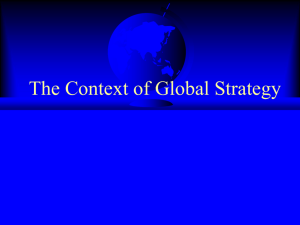
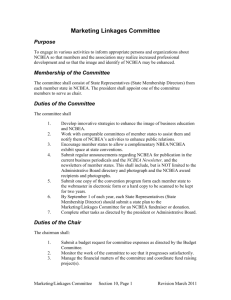
![[DOCX 51.43KB]](http://s3.studylib.net/store/data/007172908_1-9fbe7e9e1240b01879b0c095d6b49d99-300x300.png)
